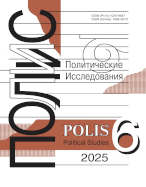Методы нейронауки при изучении мировой политики
Лебедева М. М.,
Доктор политических наук, МГИМО МИД России, Москва, Россия, mmlebedeva@gmail.com
elibrary_id: 250953 | ORCID: 0000-0003-4162-0807 | RESEARCHER_ID: C-2309-2013
Зиновьева Е. С.,
Доктор политических наук, МГИМО МИД России, Москва, Россия, elena.zinovjeva@gmail.com
elibrary_id: 625192 |
Дата поступления статьи: 2023.02.15. Принята к печати: 2023.06.29

DOI: 10.17976/jpps/2023.05.09
EDN: GAFBFW
Лебедева М. М., Зиновьева Е. С. Методы нейронауки при изучении мировой политики. – Полис. Политические исследования. 2023. № 5. С. 141-152. https://doi.org/10.17976/jpps/2023.05.09. EDN: GAFBFW
Публикация подготовлена при поддержке Программы развития МГИМО “Приоритет-2030”. Авторы благодарят рецензентов и С.В. Чугрова за замечания и рекомендации по статье.
Нейронаука активно развивается и проникает в области социальных научных исследований. По сравнению с другими областями социальных наук нейроисследования в меньшей степени затронули международные отношения и мировую политику, поскольку проведение эксперимента, являющегося основным методом нейронауки, здесь ограничено. Исследовательский вопрос статьи заключается в следующем: какие возможности открываются для изучения мировой политики и, в частности, для исследований международных переговоров при использовании нейронауки? Авторы выделяют четыре направления нейроисследований в области международных отношений и мировой политики: 1) роль когнитивных и эмоциональных процессов, проблема лидерства, сотрудничества и конфликта в международных отношениях и мировой политике при принятии решений и взаимодействии; 2) различия в протекании нейропроцессов у представителей разных культур; 3) возможность переноса данных, полученных нейробиологией, на международные отношения и мировую политику; 4) ограничения и открывающиеся преимущества применения нейронауки в международных исследованиях.
Список литературы
Анохин К.В. 2021. Когнитом: в поисках фундаментальной нейронаучной теории сознания. Журнал высшей нервной деятельности им. И.П. Павлова. T. 71. № 1. С. 39-71. https://doi.org/10.31857/S0044467721010032. EDN: TTTGKL.
Бондаренко Д.М, Гаврилов В.В., Дремлюга Р.И., Ключарев В.А., Конончук Д.В., Кузнецов А.М., Лукин А.Л., Розов Н.С., Чугров С.В., Юрченко Е.С. 2022. Современные нейро/когнитивные науки и гуманитаристика: что они могут дать друг другу? Известия Восточного института. № 2. С. 140-167. https://doi.org/10.24866/2542-1611/2022-2/140-167. EDN: CEGROW.
Глозман Ж.М., Круков П. 2013. Социальный мозг: новая трактовка понятия. Вестник Московского университета. Серия 14. Психология. № 2. С. 121-133. EDN: QCTPXT.
Дежина И.Г., Нафикова Т.Н. 2020. Мировой ландшафт нейронауки и место России. Мировая экономика и международные отношения. Т. 64. № 9. С. 37-47. https://doi.org/10.20542/0131-2227-2020-64-9-37-47. EDN: TGVXFU.
Лебедева М.М., Зиновьева Е.С. 2023. Специфика международных переговоров в эпоху цифровизации. Вестник Российского университета дружбы народов. Серия: Международные отношения. Т. 23. № 1. С. 144-156. https://doi.org/10.22363/2313-0660-2023-23-1-144-156. EDN: TQVNYC.
Науменко Т.В., Ларина Ю.М. 2020. Нейроэтика и проблемы международной безопасности. Вестник Московского государственного университета. Т. 27. Глобалистика и геополитика. № 1. С. 29-40. EDN: WCIZAX.
Agbanyo, G.K., & Wang, Y. (2022). Understanding cross-cultural differences in conceptualizing international trade patterns: a neuroeconomic perspective. Frontiers in Neuroscience, 16, 1-6. https://doi.org/10.3389/fnins.2022.916084
Alós-Ferrer, C. (2018). A review essay on social neuroscience: can research on the social brain and economics inform each other? Journal of Economic Literature, 56(1), 234-264. https://doi.org/10.1257/jel.20171370
Aquilar, F., & Galluccio, M. (2008). Psychological processes in international negotiations: theoretical and practical perspectives. Springer Science + Business Media. https://doi.org/10.1007/978-0-387-71380-9
Atzil, S, Gao, W, Fradkin, I, & Barrett, L.F. (2018). Growing a social brain. Nature Human Behaviour, 2(9), 624-636. https://doi.org/10.1038/s41562-018-0384-6
Axelrod, R., Hamilton, W.D. (1981). The evolution of cooperation. Science, 211(4489), 1390-1396. https://doi.org/10.1126/science.7466396
Boksem, M.A.S., De Cremer, D. (2010). Fairness concerns predict medial frontal negativity amplitude in ultimatum bargaining. Social Neuroscience, 5(1), 118-128. https://doi.org/10.1080/17470910903202666
Capraro, V., & Cococcioni, G. (2015). Social setting, intuition and experience in laboratory experiments interact to shape cooperative decision-making. Proceedings of the Royal Society B: Biological Sciences, 282(1811). http://doi.org/10.1098/rspb.2015.0237
De Almeida, A.T., Roselli, L.R.P., Morais, D.C., & Costa, A.P.C.S. (2021). Neuroscience tools for group decision and negotiation. In D.M. Kilgour, & C. Eden (Ed.), Handbook of Group Decision and Negotiation (pp. 315-338). Cham: Springer. https://doi.org/10.1007/978-3-030-49629-6_53
Dolan, T.M. (2016). Emotion and strategic learning in war. Foreign Policy Analysis, 12(4), 571-590. https://doi.org/10.1111/fpa.12052
Edinger, H. (2021). Theory of irrational politics: classical realist lessons on foreign policy analysis. International Studies Review, 23(4), 1181-1207. https://doi.org/10.1093/isr/viaa095
Fisher, R., Ury, W.L., & Patton, B. (2011). Getting to yes: negotiating agreement without giving in. Boston, MA: Houghton Milfflin.
Franks, D.D. (2010). Neurosociology: the nexus between neuroscience and social psychology. Springer Science & Business Media. https://doi.org/10.1007/978-1-4419-5531-9_7
Franks, D., & Turner, J. (Ed.). (2013). Handbook of neurosociology. New York, London: Springer. https://doi.org/10.1007/978-94-007-4473-8
Gammon, E. (2020). Affective neuroscience, emotional regulation, and international relations. International Theory, 12(2), 189-219. https://doi.org/10.1017/S1752971919000253
Glimcher, P.W., Camerer, C.F., Fehr, E., & Poldrack, R.A. (Ed.). (2009). Neuroeconomics: decision making and the brain. London: Elsevier Academic Press.
Holmes, M. (2014). International politics at the brain's edge: social neuroscience and a new “Via Media”. International Studies Perspectives, 15(2), 209-228. https://doi.org/10.1111/insp.12012
Holmes, M. (2018). Face-to-face diplomacy. Social neuroscience and international relations. Cambridge: Cambridge University Press. https://doi.org/10.1017/9781108264761
Jost, J.T., Nam, H.H., Amodio, D.M., & Van Bavel, J.J. (2014). Political neuroscience: the beginning of a beautiful friendship. Political Psychology, 35, 3-42. https://doi.org/10.1111/pops.12162
Kelman, H.C. (2005). Building trust among enemies: the central challenge for international conflict resolution. International Journal of Intercultural Relations, 29(6), 639-650. https://doi.org/10.1016/j.ijintrel.2005.07.011
Knopf, J.W. (2003). The Importance of International Learning. Review of International Studies, 29, 185-207. https://doi.org/10.1017/S0260210503001852
Lee, N., Broderick, A.J., & Chamberlain, L. (2007). What is ‘neuromarketing’? A discussion and agenda for future research. International Journal of Psychophysiology, 63(2), 199-204. https://doi.org/doi:10.1016/j.ijpsycho.2006.03.007
McDermott, R. (2011). New directions for experimental work in international relations. International Studies Quarterly, 55(2), 503-520. https://doi.org/10.1111/j.1468-2478.2011.00656.x
Morris, M.W., & Mason, M.F. (2009). Intentionality in intuitive versus analytic processing: insights from social cognitive neuroscience. Psychological Inquiry, 20(1), 58-65. https://doi.org/10.1080/10478400902794548
Nye, J.S. (1987). Nuclear learning and US–Soviet security regimes. International Organization, 41(3), 371-402. https://doi.org/10.1017/S0020818300027521
Price, R., & Sikkink, K. (2021). International norms, moral psychology, and neuroscience (elements in international relations). Cambridge: Cambridge University Press. https://doi.org/10.1017/9781108966610
Rizzolatti, G., Fadiga, L., Gallese, V., & Fogassi, L. (1996). Premotor cortex and the recognition of motor actions. Brain Res. Cognitive Brain Research, 3(2), 131-141. https://doi.org/10.1016/0926-6410(95)00038-0
Sanfey, A.G. (2007). Social decision-making: insights from game theory and neuroscience. Science, 318(5850), 598-602. https://doi.org/10.1126/science.1142996
Sanfey, A.G., Rilling, J.K., Aronson, J.A., Nystrom, L.E., & Cohen, J.D. (2003). The neural basis of economic decision-making in the Ultimatum Game. Science, 300(5626), 1755-1758. https://doi.org/10.1126/science.1082976
Schutt, R.K., Seidman, L.J., & Keshavan, M.S. (Ed.). (2015). Social neuroscience: brain, mind, and society. Cambridge, MA: Harvard University Press. https://doi.org/10.4159/9780674286719
Soutschek, A, Sauter, M, & Schubert, T. (2015). The importance of the lateral prefrontal cortex for strategic decision making in the prisoner's dilemma. Cognitive, Affective, & Behavioral Neuroscience, 15, 854-860. https://doi.org/10.3758/s13415-015-0372-5
TenHouten, W., Schussel, L., Gritsch, M.F., & Kaplan, C.D. (2023). Hyperscanning and the future of neurosociology. Sociological Methodology, 53(1), 139-157. https://doi.org/10.1177/00811750221128790
Wendt, A. (1992). Anarchy is what states make of it: the social construction of power politics. International Organization, 46(2), 391-425. https://doi.org/10.1017/S0020818300027764
Wright, N.D. (2015). The biology of cooperative decision-making: neurobiology to international relations. In M. Galluccio (Ed.), Handbook of International Negotiation (pp. 47-58). Cham: Springer. https://doi.org/10.1007/978-3-319-10687-8_5
Возможно, Вас заинтересуют:
Чугров С. В.,
Журналу «Вестник МГУ. Серия 25. Международные отношения и мировая политика» пять лет . – Полис. Политические исследования. 2014. №5
Лебедева М. М., Мельвиль А. Ю.,
Сравнительная политология, мировая политика, международные отношения: развитие предметных областей 130. – Полис. Политические исследования. 1999. №4
Информация ,
Представляем «Вестник Московского университета. Серия 25. Международные отношения и мировая политика». – Полис. Политические исследования. 2010. №1
Галларотти Д. М.,
Как измерять мягкую силу в международных отношениях. – Полис. Политические исследования. 2020. №1
Манойло А. В.,
Современные политические конфликты: право на вмешательство. – Полис. Политические исследования. 2017. №6




.jpg)






 версия для печати
версия для печати
.jpg)
.jpg)